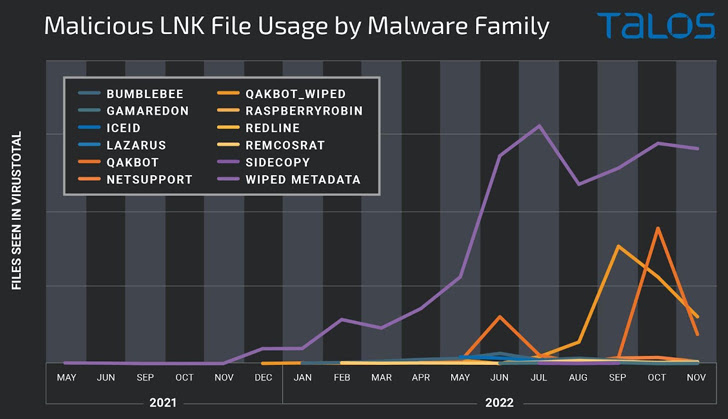Cybercriminals are increasingly leveraging malicious LNK files as an initial access method to download and execute payloads such as Bumblebee, IcedID, and Qakbot.
A recent study by cybersecurity experts has shown that it is possible to identify relationships between different threat actors by analyzing the metadata of malicious LNK files, uncovering information such as the specific tools and techniques used by different groups of cybercriminals, as well as potential links between seemingly unrelated attacks.
“With the increasing usage of LNK files in attack chains, it’s logical that threat actors have started developing and using tools to create such files,” Cisco Talos researcher Guilherme Venere said in a report shared with The Hacker News.
This comprises tools like NativeOne‘s mLNK Builder and Quantum Builder, which allow subscribers to generate rogue shortcut files and evade security solutions.
Some of the major malware families that have used LNK files for initial access include Bumblebee, IcedID, and Qakbot, with Talos identifying connections between Bumblebee and IcedID as well as Bumblebee and Qakbot by examining the artifacts’ metadata.
Specifically, multiple samples of LNK files leading to IcedID and Qakbot infections and those that were used in different Bumblebee campaigns have all been found to share the same Drive Serial Number.
LNK files have also been employed by advanced persistent threat (APT) groups like Gamaredon (aka Armageddon) in its attacks aimed at Ukrainian government entities.
The noticeable spike in campaigns using malicious shortcuts is seen as a reactive response to Microsoft’s decision to disable macros by default in Office documents downloaded from the Internet, prompting threat actors to embrace alternative attachment types and delivery mechanisms to distribute malware.
Recent analyses from Talos and Trustwave have disclosed how APT actors and commodity malware families alike are weaponizing Excel add-in (XLL) files and Publisher macros to drop remote access trojans on compromised machines.
What’s more, threat actors have been observed taking advantage of rogue Google Ads and search engine optimization (SEO) poisoning to push off-the-shelf malware like BATLOADER, IcedID, Rhadamanthys Stealer, and Vidar to victims searching for a slew of legitimate software.
BATLOADER, associated with an intrusion set tracked by Trend Micro as Water Minyades, is an “evasive and evolutionary malware” that’s capable of installing additional malware, including Cobalt Strike, Qakbot, Raccoon Stealer, RedLine Stealer, SmokeLoader, Vidar, and ZLoader.
“Attackers are imitating the websites of popular software projects to trick victims into infecting their computers and buying search engine adverts to drive traffic there,” HP Wolf Security researcher Patrick Schläpfer said.

